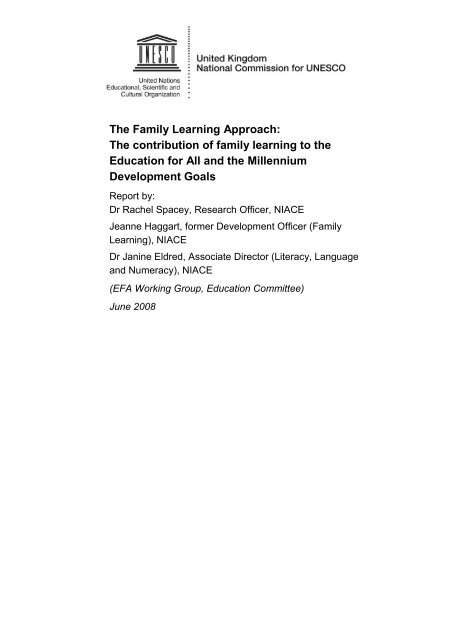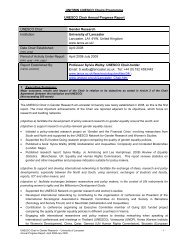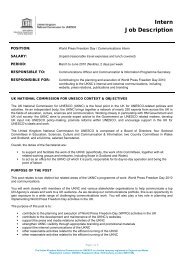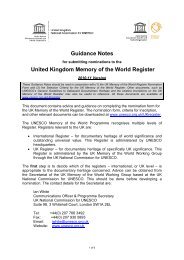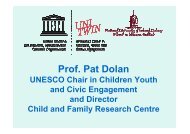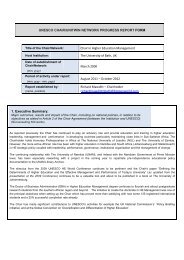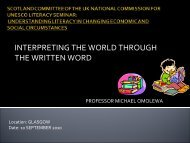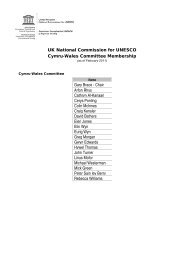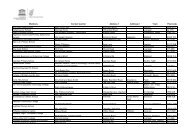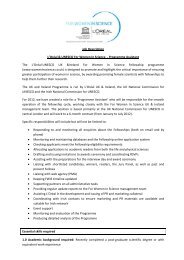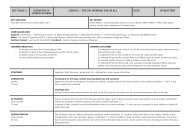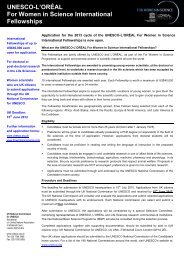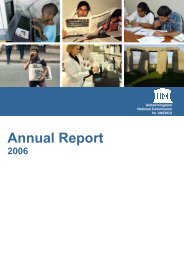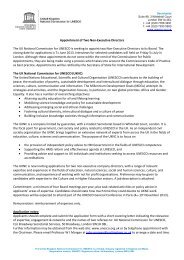The Family Learning Approach - UK National Commission for ...
The Family Learning Approach - UK National Commission for ...
The Family Learning Approach - UK National Commission for ...
You also want an ePaper? Increase the reach of your titles
YUMPU automatically turns print PDFs into web optimized ePapers that Google loves.
<strong>The</strong> <strong>Family</strong> <strong>Learning</strong> <strong>Approach</strong>:<strong>The</strong> contribution of family learning to theEducation <strong>for</strong> All and the MillenniumDevelopment GoalsReport by:Dr Rachel Spacey, Research Officer, NIACEJeanne Haggart, <strong>for</strong>mer Development Officer (<strong>Family</strong><strong>Learning</strong>), NIACEDr Janine Eldred, Associate Director (Literacy, Languageand Numeracy), NIACE(EFA Working Group, Education Committee)June 2008
<strong>The</strong> <strong>UK</strong> <strong>National</strong> <strong>Commission</strong> <strong>for</strong> UNESCO is the focal point in the <strong>UK</strong> <strong>for</strong> UNESCO (UnitedNations Educational, Scientific and Cultural Organization)-related policies and activities.As an independent body, the <strong>UK</strong> <strong>National</strong> <strong>Commission</strong> brings together a network of over 200 expertsfrom across the <strong>UK</strong> in the fields of education, culture, sciences and communication. Working closely inpartnership with HM Government and <strong>UK</strong> civil society, the <strong>UK</strong> <strong>National</strong> <strong>Commission</strong> aims to provideexpert advice to the Government on UNESCO related matters, develop <strong>UK</strong> input into UNESCO policymaking,promote re<strong>for</strong>ms within UNESCO, and encourage support in the <strong>UK</strong> <strong>for</strong> UNESCO’s ideals andwork.AcknowledgementsKind thanks to the Education <strong>for</strong> All working group <strong>for</strong> its constructive feedback on an earlier draft ofthis paper.Published by the <strong>UK</strong> <strong>National</strong> <strong>Commission</strong> <strong>for</strong> UNESCOMay 2008<strong>UK</strong> <strong>National</strong> <strong>Commission</strong> <strong>for</strong> UNESCO SecretariatSuite 98, 3 Whitehall CourtLondon SW1A 2ELUnited Kingdom+44 (0) 20 7766 3453Email: adesouza@unesco.org.ukwww.unesco.org.ukWhile every care has been taken in the preparation of this publication, by its nature it may containerrors <strong>for</strong> which the publishers cannot be held responsible. Any part of this publication may bereproduced without permission but with acknowledgment.Copies: For additional copies, contact the <strong>UK</strong> <strong>National</strong> <strong>Commission</strong> SecretariatCopyright @ <strong>UK</strong> <strong>National</strong> <strong>Commission</strong> <strong>for</strong> UNESCO 2008
TABLE OF CONTENTSLIST OF ACRONYMS ....................................................................................................................................... 2ABSTRACT ....................................................................................................................................................... 3INTRODUCTION ............................................................................................................................................... 41. FAMILY LEARNING AND ITS DEVELOPMENT IN THE <strong>UK</strong> .................................................................... 51.1. <strong>Family</strong> Literacy, Language and Numeracy .................................................................................. 51.2. Wider <strong>Family</strong> <strong>Learning</strong> ................................................................................................................... 71.3. Concerns ......................................................................................................................................... 82. EVIDENCE OF IMPROVEMENTS IN LITERACY FOR PARENTS AND CHILDREN ............................. 103. THE DEVELOPMENT OF FAMILY LEARNING OUTSIDE THE <strong>UK</strong> ........................................................ 123.1. USA.. ............................................................................................................................................... 123.2. Canada ........................................................................................................................................... 133.3. Australia ........................................................................................................................................ 133.4. New Zealand .................................................................................................................................. 143.5. Ireland ............................................................................................................................................ 143.6. South Africa .................................................................................................................................. 143.7. Uganda ........................................................................................................................................... 153.8. Transnational ................................................................................................................................ 163.9. Key features .................................................................................................................................. 164. FEATURES OF FAMILY LEARNING THAT COULD BE CONSIDERED FOR SUB-SAHARANAFRICA ..................................................................................................................................................... 175. CONCLUSIONS AND RECOMMENDATIONS ......................................................................................... 22REFERENCES ................................................................................................................................................ 23<strong>The</strong> <strong>Family</strong> <strong>Learning</strong> <strong>Approach</strong> / 2008 1
LIST OF ACRONYMSALBSUDfEEDfESEFAFABEFLLNICTLABELLNLSCMDGNALANRDCOCNPALSPEEPPEFaLPISCPLTTALWEAWFLAdult Literacy and Basic Skills UnitDepartment <strong>for</strong> Education and EmploymentDepartment <strong>for</strong> Education and SkillsEducation <strong>for</strong> All<strong>Family</strong> Basic Education<strong>Family</strong> Literacy, Language and NumeracyIn<strong>for</strong>mation and Communication TechnologyLiteracy and Adult Basic Educationliteracy, language and numeracy<strong>Learning</strong> and Skills CouncilMillennium Development Goals<strong>National</strong> Adult Literacy Agency<strong>National</strong> Research and Development Centre <strong>for</strong> Adult Literacy and NumeracyOpen College NetworkParents as Literacy SupportersPeers Early Education PartnershipParental Empowerment <strong>for</strong> <strong>Family</strong> Literacy projectPacific Islands School Community Parent LiaisonTalk To A Literacy Learner programmeWorkers’ Education AssociationWider <strong>Family</strong> <strong>Learning</strong>2 <strong>The</strong> <strong>Family</strong> <strong>Learning</strong> <strong>Approach</strong> / 2008
HMS-DATABLADHELSE- MILJØ- og SIKKERHETSDATABLADSist endret: 22.04.2008 Internt nr: Erstatter dato: 04.03.2004NITOR SALTSYRE, 30 % TEKNISKØYEKONTAKTSprut i øynene kan gi sterk svie/irritasjon og etseskader. Fare <strong>for</strong> varig synsskade og blindhet selv ved stenk av<strong>for</strong>tynnede løsninger.SVELGINGFortæring kan gi svie, etsesår, smerter i brystet, brekninger og ev. alvorlig allmennpåvirkning (sjokk). Selv småmengder kan være helsefarlig. Stor fare <strong>for</strong> permanente plager fra arrdannelse etter etseskade i spiserøret ogmagen.ANNEN TOKS. INFORMASJONToksikologiske data finnes kun <strong>for</strong> inngående stoffer, ikke <strong>for</strong> bearbeidingen.12. MILJØOPPLYSNINGERØKOTOKSISITETIkke ansett <strong>for</strong> å være miljøfarlig. Noen større utslipp eller stadig gjentatte mindre utslipp kan være skadelig <strong>for</strong>eller virke <strong>for</strong>styrrende på miljøet. Utslipp til vannresipienter kan gi økt pH, noe som medfører fare <strong>for</strong> skader påorganismer som lever i vann.MOBILITETVannløslig.BIOAKKUMULERINGSPOTENSIALIkke bioakkumulerbar i vannmiljøer.ANNEN INFORMASJONKontakt berørte myndigheter ved større utslipp.13. FJERNING AV KJEMIKALIEAVFALLGENERELTBehandles som farlig avfall. Leveres til avfallshåndtering. Mindre mengder kan helles ut i avløp etternøytralisering. Tømte og rengjorte <strong>for</strong>pakninger kan gjenvinnes eller brennes. Foretaket er tilknyttet REPA.AVFALLSGRUPPERAvfallstype angis med en sekssifret EAK-kode. EAK-koden er bare et <strong>for</strong>slag, sluttbrukeren velger en egnet EAKkode.14. OPPLYSNINGER OM TRANSPORTKjemikaliet er klassifisert som farlig gods: Ja Nei Ikke vurdertUN-nr: 1789VARENAVN OG BESKRIVELSE:5 / 7
INTRODUCTIONThis paper scopes <strong>UK</strong> developments in family literacy and family learning over the past two decades.<strong>Family</strong> literacy and learning within a wider international context is also considered, in conjunction withways in which to develop effective community learning provision. Models and lessons learned fromresearch and evaluation are considered in terms of their applicability to meeting the Education <strong>for</strong> All(EFA) and Millennium Development Goals (MDGs).<strong>The</strong> phrase ‘family literacy’ was introduced by Denny Taylor in 1983 and family literacy programmesbegan in the USA, England and Israel in the 1970s and 1980s (Thomas, 1998, in Benseman, 1992).Hannon and Bird distinguish between two meanings of the term family literacy: firstly, literacy practiceswithin families; and secondly, literacy programmes that involve families (in Wasik, 2004). <strong>The</strong> <strong>for</strong>mermay be spontaneous, as Morrow notes, ‘Sometimes, family literacy occurs naturally during theroutines of daily living and helps adults and children “get things done”. <strong>The</strong>se events might includeusing drawings or writings to share ideas; composing notes or letters to communicate messages;making lists; reading and following directions; or sharing stories and ideas through conversation,reading and writing’ (1995, p. 7). In contrast, literacy programmes teach literacy, while acknowledgingand making use of the learners’ family relationships and engagement in family literacy practices(Hannon & Bird, in Wasik, 2004). <strong>Family</strong> literacy appears to be the preferred term used outside the<strong>UK</strong>.‘<strong>Family</strong> learning’ represents an umbrella term under which a wide range of models are in operation,including family literacy practices and family literacy programmes. In this review of the literature, theterm family learning is used primarily, but not exclusively, in the <strong>UK</strong>. It is generally understood to referto learning approaches that engage parents and children jointly in learning, ranging from initiativessuch as ‘Bookstart’ in the <strong>UK</strong>, where book bags are distributed through health visitors to stimulateearly book sharing in families, to the wide range of family programmes funded through the <strong>Learning</strong>and Skills Council (LSC) in England, which falls into two categories, <strong>Family</strong> Literacy, Language andNumeracy (FLLN) and Wider <strong>Family</strong> <strong>Learning</strong> (WFL). <strong>The</strong> LSC tends to refer to ‘family programmes’as the overarching term, with WFL and FLLN as its two subsets (Heathcote & Brooks, 2005).<strong>Family</strong> learning provides a way to develop the skills of both children and adults while helping todevelop other ‘softer’ qualities, such as confidence. <strong>The</strong> World Conference on Education <strong>for</strong> All in1990 positioned basic education high on its agenda. In 2000, delegates from 164 countries reaffirmedtheir commitment to EFA in Dakar, Senegal. <strong>Family</strong> learning provides one practical solution to two ofthe six EFA goals; to expand early childhood care and education and to expand adult literacy by 50%by 2015 (UNESCO, 2000). In particular, countries in Sub-Saharan Africa face considerable challengesin meeting the EFA targets. It is estimated that in Sub-Saharan Africa, 88 million additional schoolplaces will need to be found <strong>for</strong> children while, in relation to adult literacy, success requires more thana doubling of previous ef<strong>for</strong>ts to achieve the target of 50%. Similarly, the eight MDGs, which areagreed to by all the countries of the world and all leading development institutions, include achievinguniversal primary education by 2015. This paper reflects on the lessons learned in the <strong>UK</strong> andinternationally in the development of family learning to identify models, which may be usefully adaptedto help in the achievement of two of the EFA goals and one MDG identified above.4 <strong>The</strong> <strong>Family</strong> <strong>Learning</strong> <strong>Approach</strong> / 2008
1. FAMILY LEARNING AND ITS DEVELOPMENT IN THE <strong>UK</strong><strong>The</strong> use of the term family learning in the <strong>UK</strong> appears in the literature in the 1990s, <strong>for</strong> example,Alexander and Clyne’s publication <strong>for</strong> the <strong>National</strong> Institute of Adult Continuing Education (NIACE) in1995, Riches Beyond Price: Making the Most of <strong>Family</strong> <strong>Learning</strong>.<strong>Family</strong> learning describes learning ‘which takes place among family members’ – intergenerationallearning, although it usually refers to programmes or ‘what people outside the family do to enable andfacilitate the learning that goes on in families’ (Haggart, 2000, p. 3). <strong>Family</strong> is defined in its widestsense to mean a network of ‘intergenerational relationships in which people care <strong>for</strong> each other’(Haggart 2000, p.5); this may mean parents/carers, grandparents, childminders, foster parents, otheradults and older children.1.1. <strong>Family</strong> Literacy, Language and NumeracyFLLN provision has developed in the context of adult literacy and early childhood education provision(Hannon & Bird, in Wasik, 2004). In the 1970s, the <strong>UK</strong> government drew attention to the issues ofadults with literacy and numeracy requirements. Provision was developed through the On the Movecampaign, with classes taught by tutors funded by local education authorities, voluntary organisations,colleges and adult education institutions. In the 1980s, family literacy focused on school-initiatedprogrammes and non-school reading groups (Harrison, in Morrow, 1995). <strong>The</strong> latter included the<strong>Family</strong> Reading Groups project and Bookstart. <strong>The</strong> first family reading groups involved parents,teachers, and school and public librarians Hannon and Bird describe the use of reading workshops,family reading groups and prescriptive approaches to parents listening to their children read duringthis period (in Wasik, 2004).In 1993, the Adult Literacy and Basic Skills Unit (ALBSU) published Parents and their children. Thisstudy reported that 60% of children in the lowest reading attainment group at age ten had parents withlow literacy scores, whereas only 2% had parents with high literacy scores (1993). In 1995, Bynnerand Steedman published research findings that seemed to indicate that FLLN programmes were likelyto produce positive improvements <strong>for</strong> parents and children in disadvantaged circumstances. A grantwas made available <strong>for</strong> pilot projects, based on the American model of ‘teach the mother, reach thechild’ of the 1980s, to be organised by the ALBSU (McLeod, 1993). Four demonstration programmeswere run in England. <strong>The</strong> programmes worked with both parents with few or no qualifications incourses that lasted 96 hours over 12 weeks (Hannon & Bird, in Wasik, 2004). In the 1990s, Hannondeveloped a framework to conceptualise family literacy programmes, suggesting that families shouldprovide children with four requirements – known as ORIM. <strong>The</strong> ORIM framework has been used in anumber of programmes, including the ALBSU demonstration programmes (Hannon & Bird, in Wasik,2004):ORIMOpportunities to read texts, to attempt writing, and to talk about literacy.Recognition of early literacy achievements, including the earliest sign of emergent literacy.Interaction with more proficient literacy users.Models of what it is to use written language in everyday family social practices, at work andin the community.<strong>The</strong> <strong>Family</strong> <strong>Learning</strong> <strong>Approach</strong> / 2008 5
<strong>Family</strong> Literacy and <strong>Family</strong> Numeracy demonstration programmes were expanded with funding fromthe Standards Fund in the late 1990s, which came from the Department <strong>for</strong> Education and Skills tolocal authorities with support from the Basic Skills Agency. <strong>The</strong> monies were allocated on indices ofdeprivation. Other family learning activity with families drew on local authority budgets, while theCommunity Education Development Centre (now ContinYou) developed nationally recognisedprogrammes such as SHARE, involving parents in their children’s learning at primary and secondaryschool level.In 2000, the LSC was set up to fund adult and community learning. <strong>The</strong> Department <strong>for</strong> Education andSkills sent Standards Fund money through the LSC. Consequently, the two traditions of 1) familyliteracy and family numeracy and 2) other family learning under the rubric of WFL, were maintained.Funding <strong>for</strong> family learning from the LSC commenced in 2002.<strong>Family</strong> literacy and family numeracy were encompassed by the Skills <strong>for</strong> Life agenda, which focuseson the literacy, language and numeracy skills of adults, of which parents and other primary carers area key priority group. Skills <strong>for</strong> Life was a response to the Moser report on post-school basic skills. <strong>The</strong>report of the working group, A Fresh Start – Improving Literacy and Numeracy (1999), maderecommendations <strong>for</strong> a national strategy and highlighted the scale of adult literacy need, that of sevenmillion adults in England who were ‘not functionally literate’. Key elements include targets of improvingthe literacy and numeracy skills of 750,000 adults by 2004, 1.5 million by 2007 and 2.25 million by2010. As part of this national strategy, FLLN programmes have been part of a major drive to buildcapacity and improve standards.FLLN programmes feature the following elements:• a common learning process, known as a ‘learning journey’, ensuring that learners experienceeight essential stages in their learning;• learning outcomes mapped to a core curriculum in literacy, language and numeracy;• training programmes <strong>for</strong> staff, linked to national standards;• a body of guidance documents and resource materials <strong>for</strong> practitioners;• a national test that recognises achievement;• nationally provided training programmes <strong>for</strong> staff.In 2004/5, <strong>for</strong> example, there was a range of LSC-funded FLLN programmes in existence (DfES,2004b). <strong>The</strong>y included taster courses and workshops of a one-off nature or short duration, such as a‘Play and Language Taster’ where parents with few or no qualifications are encouraged to talk to andplay with their babies and young children. This session sets out the importance of play in children’searly language development. Introductory programmes such as ‘Keeping up with the Children’introduce parents/carers to the ways in which their children are taught at school in the literacy hourand in maths lessons. Programmes such as this give parents the confidence to support their childrenand to develop their own literacy and numeracy skills. <strong>The</strong>re are six short programmes <strong>for</strong>parents/carers of school-age children, to raise the literacy standards of both parents and children andhelp develop parents’ skills in supporting the literacy development of their children. Finally, there areintensive programmes – again designed to help raise standards of literacy, numeracy and language ofboth parents/carers and children.6 <strong>The</strong> <strong>Family</strong> <strong>Learning</strong> <strong>Approach</strong> / 2008
1.2. Wider <strong>Family</strong> <strong>Learning</strong>In contrast, there has not been one single key government policy driving the development of WFLprogrammes; rather, it has developed in response to a number of policy initiatives and moves by othersectors to develop learning provision. For example, raising standards in schools, lifelong learning,widening participation and engaging ‘hard to reach groups’, the Every Child Matters: Change <strong>for</strong>Children (DfES 2004a) agenda encapsulated in the Children Act (2004), Extended Schools, Sure StartChildren’s Centres and Skills <strong>for</strong> Life have all shaped the development of WFL; while the Museums,Libraries and Archives sector has built upon its ability to provide in<strong>for</strong>mal learning opportunities todevelop family learning opportunities. This has meant that WFL development has had greater flexibilityand worked within broader contextual aims and objectives, such as promoting community cohesion.For example, in Scotland, family learning has developed in the context of community education anddevelopment contexts (NALA, 2004), to tackle deprivation and regenerate communities.WFL programmes are distinguishable from FLLN programmes in that the <strong>for</strong>mer may have literacyand numeracy embedded within them, while they are the primary purpose of the latter (Lochrie, 2004).Many WFL programmes are developed locally and accredited through local Open College Networks(OCNs). <strong>The</strong>re are, however, some notable national programmes, including the Workers’ EducationAssociation (WEA)’s ‘Helping Your Child in School’ and ContinYou’s ‘SHARE’ programmes. <strong>The</strong> widecurricula offered to parents/carers in WFL are successful in engaging adults who may then progress toFLLN programmes, and vice versa. WFL programmes may include ‘<strong>Family</strong> ICT’, ‘Storysacks’, art andcraft, languages, healthy eating and sports-themed activities.SHARE, <strong>for</strong> example, is offered in early years, infant, junior, secondary, and other community settings.It is delivered by facilitators who have been trained in the use of the materials. Facilitators can supportparents in a number of ways, including running meetings and/or structuring group sessions.Parents/carers are encouraged to work with their children at home using the SHARE materials, whichcomplement classroom teaching and literacy and numeracy frameworks. Parents can gainaccreditation <strong>for</strong> their work, as the programme is accredited by the OCN. Similarly, Peers EarlyEducation Partnership (PEEP) supports parents as their children’s first educators and enables parentsto learn themselves. <strong>The</strong> <strong>Learning</strong> Together programme, developed over the last ten years, is acombination of activities including sharing books, singing, playing, listening and doing crafts. PEEPalso uses the ORIM framework. PEEP is a flexible programme that can be adapted <strong>for</strong> use in a varietyof settings and with different communities. <strong>The</strong>re are a number of ways in which PEEP is used,including home visits made when babies are young to invite parents/carers to attend a group; homeprogrammes <strong>for</strong> a one-to-one approach; and weekly PEEP group sessions.<strong>Family</strong> learning in England has undergone a great deal of development from family reading groups inthe 1970s to systematic funding of a wide range of programmes delivered through local authorities in avariety of community settings. LSC-funded programmes are complemented by successful nationalprogrammes such as SHARE. <strong>The</strong> numerous governmental policy strands that have encouraged thedevelopment of family learning have seen its growth in settings such as Children’s Centres, ExtendedSchools, museums, libraries and archives, workplaces, prisons, colleges and community learninglocations, funded through a variety of sources including, but not limited to, government funding via theLSC. <strong>The</strong> delivery of family learning, whether via <strong>for</strong>mal programmes funded by the LSC or morein<strong>for</strong>mal learning opportunities in a variety of locations such as libraries, is reliant on family learningpractitioners working with colleagues to draw on expertise and resources.<strong>Family</strong> learning practitioners and services in England have been successful in engaging with a widerange of families. A number of local authority <strong>Family</strong> <strong>Learning</strong> Services in England have engaged with<strong>The</strong> <strong>Family</strong> <strong>Learning</strong> <strong>Approach</strong> / 2008 7
Traveller families, <strong>for</strong> example. Development work with this diverse group may be appropriate since‘Travellers have a strong culture of in<strong>for</strong>mal and family learning, often engendered through oral andpractical means that fit the patterns and needs of their lifestyle’ (NIACE, 2006, p. 43). For example, inDerbyshire, a development worker employed by Read On – Write Away! (ROWA!), worked one day aweek, building relationships with Traveller families on site. <strong>The</strong> ROWA! bus was parked on site <strong>for</strong> onemorning each week and a course, ‘Backpack’, involved parents and children enjoying a wide range ofactivities, including listening, speaking, literacy and numeracy skills. To encourage the families toattend, a different activity or book was added to the backpack at each session. <strong>The</strong> parents on theTraveller site asked the development worker <strong>for</strong> further learning opportunities (NIACE, 2006). InOx<strong>for</strong>dshire, Irish Traveller families from two Traveller sites attended monthly workshops offered in alocal church hall. <strong>The</strong>se women-only sessions, which were the preference of the learners, includedtopics such as learning styles, phonics and reading, making games and sharing books with children.Similarly, attendance at these initial workshops led to families joining FLLN sessions (NIACE, 2006).<strong>Family</strong> learning is also used successfully to engage with asylum seekers, refugees and migrants. Itcan be used to illustrate to parents/carers the kinds of learning and teaching their children mayexperience in the <strong>UK</strong>. English <strong>for</strong> Speakers of Other Languages (ESOL) can be combined with familylearning programmes to <strong>for</strong>m <strong>Family</strong> ESOL. In Liverpool, <strong>for</strong> example, a bilingual family learningprogramme also links with classes in subjects such as sewing, cookery, gardening, crafts and ICT.<strong>The</strong> flexibility of WFL enables it to be shaped to the requirements of local families and it can there<strong>for</strong>eattract minority ethnic families or Traveller families. <strong>The</strong> notion of parents/carers doing something tohelp their children successfully appeals to adults across cultural, religious and other socio-economicdivisions; doing something <strong>for</strong> the family is seen as a legitimate activity. Parents/carers may thendiscover engagement in family learning stimulates a thirst <strong>for</strong> further learning. In recent years, theWFL approach has been used to develop taster sessions, activities and programmes in a wide rangeof curriculum and subject areas, including health, sport, music, drama, art, gardening, nature andwildlife, craft, cooking, play, child development, cultural awareness, dance, massage, photography,disability awareness, genealogy, first aid, ICTs, poetry, history, sign language and storytelling.In England, the Campaign <strong>for</strong> <strong>Learning</strong> is funded to support <strong>Family</strong> <strong>Learning</strong> Week. Presently, thisinvolves nine days of family focused learning activities run by organisations such as schools, healthcentres, libraries, museums, sports centres, community centres and colleges. Its aim is to attractfamilies that would not normally be engaged in learning with in<strong>for</strong>mal, fun activities and then signpostthem to further learning opportunities. <strong>Family</strong> <strong>Learning</strong> Week began as <strong>Family</strong> <strong>Learning</strong> Day in 1998and its growth to nine days in 2006 is indicative of its popularity – in 2005, approximately 5,000organisations were involved. <strong>The</strong> activities in <strong>Family</strong> <strong>Learning</strong> Week are also used to attract‘disadvantaged groups including those from deprived areas, with learning difficulties, some ethnicminorities and those with physical disabilities’ (Campaign <strong>for</strong> <strong>Learning</strong>, 2006).1.3. Concerns<strong>The</strong> development of family learning is not without criticism.• <strong>Family</strong> literacy education began with a ‘transmission’ model of literacy – from school to home.<strong>The</strong>re was an assumption that children with low levels of literacy came from homes with poorliteracy practices (Mace, 2003). <strong>Family</strong> literacy programmes were a means to transmit schoolliteracy practices into the home, which was criticised as representing a ‘deficit’ approach (see,<strong>for</strong> example, Auerbach, in Taylor, 1997).8 <strong>The</strong> <strong>Family</strong> <strong>Learning</strong> <strong>Approach</strong> / 2008
• Arguably, family learning programmes which, while not aimed exclusively at women, areattended by women in the main (see, <strong>for</strong> example, Ofsted, 2000), could be perceived as bothempowering <strong>for</strong> women and oppressive. To give mothers an opportunity to acquire other<strong>for</strong>ms of literacy and skills may prove helpful in relation to the development of roles in thecommunity, in commerce and in spheres outside the home. Conversely, family learning canserve to confirm women’s role as carers of their children and places the responsibility <strong>for</strong> theireducational development firmly on their shoulders. As Smythe and Isserlis argue, ‘the workand power of institutions that promote family literacies policies and programmes, such asschools, government education departments and welfare agencies, are influenced bylongstanding “mothering discourses” that represent culturally-bound beliefs and valuessurrounding who and what constitutes a good mother, a normal family and by extension,appropriate literacy and pedagogical practices in the home’ (2002, p. 2).<strong>The</strong> <strong>Family</strong> <strong>Learning</strong> <strong>Approach</strong> / 2008 9
2. EVIDENCE OF IMPROVEMENTS IN LITERACY FOR PARENTS ANDCHILDREN<strong>The</strong>re is evidence to suggest that family literacy impacts positively upon the literacy (and other) skillsof parents and children. In England, <strong>for</strong> example, evaluation of the ALBSU early family literacyprogrammes carried out by the <strong>National</strong> Foundation <strong>for</strong> Educational Research (Brooks et al., 1996)found that 91% of parents who completed the course improved their reading and writing skills, with95% of these attaining accreditation of some <strong>for</strong>m. <strong>The</strong> courses also impacted upon family behaviour,with families spending more time together with learning activities embedded in daily practices. Followupresearch with 154 parents who had participated in the family literacy programmes between two andthree years previously found that over 85% of parents thought that their reading and writing skillscontinued to improve, while over half of the parents were involved with their children’s school,accompanying outings, attending meetings and taking on roles such as literacy helpers (Brooks et al.,1997).Focus group research with parents participating in family literacy and numeracy programmes inLondon, England, found a number of benefits <strong>for</strong> those who took part, including gains in confidenceand independence, opportunities to meet people and to develop support networks, and parents havinga better understanding of the needs of their children (Brassett-Grundy, 2002). Similarly, in NewZealand, an evaluation of the Manukau <strong>Family</strong> Literacy Programme found that there were positiveimpacts on adult participants (Ministry of Education, 2004). Prior to the programme, they were askedto consider whether they had difficulties with maths, reading, spelling, English or writing. Comparedwith the ratings at the end of the programmes, it was discovered that the average self-rating in literacyhad risen from 4.6 to 7.9, while self-confidence had increased from 5.7 to 9.6 on a scale from 1 to 10where 1 represents ‘considerable difficulty’ and 10 represents ‘no/few difficulties’. <strong>The</strong> adults also feltmore confident about helping their children with homework, and their family relationships generallyhad improved as a result of effective discipline and understanding educational processes.Similarly, there is research to suggest that family learning also impacts positively upon adults inrelation to literacy skills, confidence and community involvement. An evaluation of the first two years ofthe SHARE programme (Bastiani, 1999) developed by ContinYou (<strong>for</strong>merly the Community EducationDevelopment Centre), which in England is categorised as WFL, identified a number of benefits,including improvements in the achievement and progress of many pupils and greater involvementbetween schools and parents. Parents’ confidence increased and many developed strongrelationships with other parents. An evaluation of the programme in 2005 found that the programmewas most commonly used with parents of nursery and primary-aged children. Running groups on aweekly basis was the most popular mode of operation, with mothers as the family members most likelyto attend, although fathers, grandparents, aunts, brothers, sisters and childminders had also attended.A six-year study of the PEEP programme (Evangelou et al., 2005) of more than 600 children foundthat they made significantly greater progress in literacy related skills compared with children who werenot involved in PEEP. In addition, there appeared to be gains in their self-esteem, with PEEP childrenrated higher on this by the age of five. <strong>The</strong> Enabling Parents project, which explored the impacts of theprogramme on parents/carers through comparing the experiences/attitudes of those who had takenpart in the programme with a group that had not, found that the socio-economic status of the mothersimproved, parents had a greater understanding of their child’s literacy development, and participantsfelt able to return to some <strong>for</strong>m of <strong>for</strong>mal education (Sylva et al., 2004).10 <strong>The</strong> <strong>Family</strong> <strong>Learning</strong> <strong>Approach</strong> / 2008
<strong>The</strong> NIACE evaluation of LSC-funded programmes across all local education authorities in Englandfound that, in relation to WFL, a number of gains were reported <strong>for</strong> parents, including raisedconfidence, making new friends, sharing activities with their children, acquiring new skills and thedevelopment of a support network (NIACE, 2003). Similarly, FLLN learners reported gains inconfidence. A NIACE evaluation of family learning in Lancashire, England, found that parents enjoyedfocusing on their children as well as learning <strong>for</strong> themselves. In terms of impacts, adults attendingFLLN and WFL both reported gains in confidence, however, a higher number of parents who hadparticipated in FLLN stated that they felt more confident in undertaking further learning than thoseparents who had participated in WFL (Horne & Haggart, 2004). In relation to the wider community,parents attending family learning courses were more likely to become involved in their child’s schooland over half of parents nearing the end of their course had made friends through attending familylearning courses. <strong>Family</strong> learning programme attendance was also related to community involvement,with 15% of parents who had taken part in family learning over a year ago indicating that they weremore involved in their community.<strong>The</strong> evidence that is available in relation to family learning in the <strong>UK</strong> suggests that programmesimprove both children’s and adults’ levels of literacy and confidence. Furthermore, there are a numberof wide-ranging benefits to families, including family members spending more time together andhaving better relationships with one another and with other families. Adults were more likely tobecome involved in their children’s schools, volunteer or get involved in their communities as a resultof family learning.<strong>The</strong> <strong>Family</strong> <strong>Learning</strong> <strong>Approach</strong> / 2008 11
3. THE DEVELOPMENT OF FAMILY LEARNING OUTSIDE THE <strong>UK</strong>Much international family learning provision has been influenced by developments in the USA. Outsideof the <strong>UK</strong>, family literacy is the preferred term of usage and the majority of the programmes discussedin this section are certainly identifiable as family literacy even if they are not referred to as such in theirtitles. <strong>The</strong> following section considers family literacy and family learning in a number of countries.3.1. USA<strong>The</strong> best-known model <strong>for</strong> family literacy in the USA is the Kenan model, which developed from Parentand Child Education programmes piloted in 1986 (NALA, 2004). <strong>The</strong> programmes aimed to developthe skills and confidence of parents. Provision from the Kenan Trust was used to establish the<strong>National</strong> Center <strong>for</strong> <strong>Family</strong> Literacy in Kentucky. <strong>The</strong> Kenan model consists of four components:• Adult Education;• Children’s Education;• Parent and Child Together Time;• Parent Time.This model is used as the basis <strong>for</strong> a number of family literacy services in the USA. Parents taking partin the programme attend classes <strong>for</strong> three days a week over the course of a year. Benseman arguesthat it is this length and intensity that is crucial to the effectiveness of the programme (Benseman, inNALA, 2004). Even Start, the national programme introduced in 1989, was based on the Kenan modeland integrated adult and parenting education with early childhood education <strong>for</strong> the mostdisadvantaged families. Intergenerational learning, or adults and children learning together, has beena key part of the programme and ‘impresses upon parents that they are key to their children’seducation’ (McKee & Rhett, in Morrow, 1995). <strong>The</strong> national evaluation of Even Start found that familiesbenefited from intensive and continuous instruction. In the USA, family literacy services share anumber of commonalities as a result of legislation, including the Elementary and Secondary EducationAct (Even Start), the Head Start Act, the Reading Excellence Act (Benseman, 2002).<strong>The</strong> Barbara Bush Foundation <strong>for</strong> <strong>Family</strong> Literacy, founded in 1989, has also influenced thedevelopment of family literacy in the USA. In the first five years of the foundation, 52 family literacy orreading programmes in 32 states were funded or extended. No single model was utilised, but theprogrammes were guided by the principle that the literacy behaviours and skills of adults can beimproved by those adults helping their children.<strong>Family</strong> literacy research in the USA has challenged a number of assumptions about the rationale <strong>for</strong>programmes and the home experiences of children with low literacy levels. For example, it haschallenged the assumption that the homes of adults who are low income, minority ethnic and <strong>for</strong> whomEnglish is a second language, are literacy impoverished. Rather, it became clear from a review of theevidence that often the opposite is true, as education and literacy are seen as ways to advance insociety and that literacy is used <strong>for</strong> many different purposes (Auerbach, in Morrow, 1995). Auerbachalso identified the value of situating literacy in relevant social contexts, such as health issues and theneed to look at community practices as the basis <strong>for</strong> in<strong>for</strong>ming school practices. She argued thatfamily literacy programmes should incorporate community cultural norms, existing literacy practicesand social issues into the content of the curriculum.A number of popular programme models also focused on adults learning how to share books with theirchildren. Shared book reading has been a focus of research and practice in the USA <strong>for</strong> the last 2012 <strong>The</strong> <strong>Family</strong> <strong>Learning</strong> <strong>Approach</strong> / 2008
years (Gadsden, in Morrow, 1995). For example, the Parents as Partners in Reading Programmedeveloped from research that revealed that parents were often instructed by schoolteachers to readwith their children, but did not know how or why this activity related to their children’s development.Similarly, it emerged from conversations with teachers that some of their perceptions of the parentswere unfounded and there was no appreciation that some parents struggled with reading. <strong>The</strong>programme was held in a community library with access to children’s books, and parents receivedinstruction on how to read and share books effectively with their children (Edwards, in Morrow, 1995).3.2. Canada<strong>The</strong>re is no single programme of family learning used in Canada but there has been some work ondeveloping programmes <strong>for</strong> First Nations communities 1 . For example, Parents as Literacy Supporters(PALS) is a programme <strong>for</strong> parents to support their children’s development and is under developmentto fit the needs of First Nations communities who have a very strong oral tradition and whose cultureand identity is threatened by language loss. In Alberta, activity is guided by a Parent-Child LiteracyStrategy initiated in 2000. <strong>The</strong> strategy aims to integrate adult literacy instruction with oral languagedevelopment <strong>for</strong> young children in socially and economically deprived localities. <strong>The</strong> strategyrecognises and respects the cultural and spiritual traditions of families and children and includes adistinct family literacy component <strong>for</strong> Aboriginal families. <strong>The</strong>re are a number of family literacyprogrammes/models used in Alberta that, which are very similar to family learning programmes in the<strong>UK</strong>. Examples include ‘Books <strong>for</strong> Babies’, which encourages parents to read with their children,delivered through community libraries and health professionals; ‘Storysacks’, where a cloth bag ismade containing props relating to the story inside, which is used in various settings to support reading,and ‘Rhymes That Bind’ where parents and their children enjoy rhymes, stories and songs, sometimescalled ‘Baby Rhyme Time’ in England. <strong>The</strong> latter is particularly useful <strong>for</strong> adults with low or no literacyskills since a completely oral <strong>for</strong>mat is used.3.3. AustraliaIn Australia, the Talk To A Literacy Learner (TTAL) programme is used in over 400 schools (NALA,2004). It involves 16 two-hour workshops on topics that include learning, literacy and the role ofparents. <strong>The</strong> programme was designed to focus on adults rather than children, enabling parents toreflect on their behaviours and the roles they assume when interacting with their children in relation toreading and writing (Cairney, 1992). <strong>The</strong> programme includes some joint sessions where parentswork/learn with their children and some adult-only sessions. <strong>The</strong> project has three distinct stages overan 18-month period. <strong>The</strong> first stage involves working with parents to promote literacy development andmake more use of literacy resources within their community.and enable them to interact effectivelywith their children as they are engaged in literacy practices. Stage 2 involves workshops <strong>for</strong> parentsfrom stage 1 who are interested in becoming community or school tutors; parents gain greaterknowledge of literacy and work with children in the school. In stage 3, a number of parents are trainedto act as community tutors.This model would seem a useful one to adopt as adults initially attending the course are empoweredto assist others in school and in the community. However, evaluatory research of TTAL has found thatparents’ self-confidence and esteem improves, but it does not explicitly refer to improvements inliteracy.1 First Nations is a term used in Canada to denote the indigenous peoples of North America who are not Inuit or Métis.<strong>The</strong> <strong>Family</strong> <strong>Learning</strong> <strong>Approach</strong> / 2008 13
3.4. New Zealand<strong>Family</strong> literacy programmes in New Zealand have lacked the instructional intensity of programmeselsewhere (Benseman, 1992). <strong>The</strong> Pacific Islands School Community Parent Liaison (PISCPL)project, however, is a useful example of a scheme that fosters closer relationships betweencommunities and schools. Officially launched by the ministry of education in 1996, evaluation of theproject reveals a number of critical factors crucial to its success, including the appointment of acommunity liaison coordinator. <strong>The</strong> coordinators work with the local community, teachers and schoolprincipals. <strong>The</strong>ir remit includes visiting parents at home, facilitating communication between schoolsand communities, encouraging parents to become involved in programmes and to attend events, andfacilitating ‘focussed interventions to grow parent capability so that they could help in school relatedactivities e.g. reading programmes, homework centres’ (2004, p. 10). In terms of encouraging studentparticipation, learning and achievement, initiatives such as Polynesian clubs, which reflect culturalexperiences such as song, dance, arts and crafts, are popular, as is the heightened visibility of culturalicons in schools. In relation to family learning, programmes include a parent reading tutor programmedesigned to help parents support their children’s learning, and literacy programmes involving parentssupporting their children.In common with family learning development in the <strong>UK</strong>, the Manukau <strong>Family</strong> Literacy Programme inNew Zealand has been influenced by the work of the <strong>National</strong> Center <strong>for</strong> <strong>Family</strong> Literacy in the USA. Itis aimed at improving the literacy skills of both adults and children and subscribes to the Kenan model,with four components including various <strong>for</strong>ms of Parent and Child Together Time. <strong>The</strong> ministry ofeducation evaluation report of the programme revealed that the Manukau programme requires eachparent to officially nominate one child to be the focus of the family literacy activities. <strong>The</strong> rationale <strong>for</strong>this includes administrative arrangements and an assumption that involving multiple children wouldsomehow ‘dilute’ the programme’s impact (ministry of education, 2004).3.5. IrelandAccording to the <strong>National</strong> Adult Literacy Agency (NALA) in Ireland, family literacy programmes havedeveloped with adult education, libraries, schools and community projects since the early 1990s. Inrelation to their development, partnership is a key feature of successful family literacy programmes,particularly with schools and community development projects. <strong>The</strong> Clare <strong>Family</strong> <strong>Learning</strong> Project,which began in 1994, focused on the importance of the home in early learning and how children andadults learn. In 2000, the project produced a <strong>Family</strong> <strong>Learning</strong> Resource Pack, which included a set ofworkbooks <strong>for</strong> parents, a resource guide and a ‘photopak’ of colour photos showing the variouslearning activities that take place in families. <strong>The</strong> photopak can be used to generate discussion andraise awareness of the opportunities to use literacy in everyday situations. Using 14 sessions, thisbecame the basis <strong>for</strong> a 28–30 hour course that includes a range of topics such as everyday writing,rhymes, songs and poems, storytelling, sharing books, making a book and exploring the links betweenoral language in everyday living and the home (NALA, 2004).3.6. South AfricaIn Cape Town, South Africa, the Families <strong>Learning</strong> Together Project emerged from Parents andSchools <strong>Learning</strong> Clubs instigated by parents to address underachievement among young people.This involved family members sharing their experiences and culture with their children as a basis <strong>for</strong>literacy development, as seen in the example from New Zealand mentioned above. <strong>The</strong> projectpromotes literacy by involving family members in literacy and development activities. Workshops areutilised to give family members the opportunity to consider ways of working with their children ontopics such as story reading and writing, family history and learning about what their children learn at14 <strong>The</strong> <strong>Family</strong> <strong>Learning</strong> <strong>Approach</strong> / 2008
school. Joint child and adult activities include cooking as a means to connect home and schoolknowledge (NALA, 2004). Staff running Parents and Schools <strong>Learning</strong> Clubs discovered that many ofthe parents could not read or write English whereupon they translated materials into African languageswith which the parents were familiar. This encouraged families to share knowledge of family trees,poems, totems, recipes, recreation and music, which were recorded by other family members whowere literate (Mashishi, 2001, in Prinsloo, 2005). <strong>The</strong> parent workshops also used available resourcessuch as scraps of material, junk mail and cereal boxes to produce learning and teaching aids(Mashishi & Cook, in DeBruin-Parecki & Krol-Sinclair, 2003).<strong>The</strong> Storysacks idea used in Canada and in the <strong>UK</strong> was adapted <strong>for</strong> the Families <strong>Learning</strong> Togethercontext. <strong>The</strong> families involved in Families <strong>Learning</strong> Together do not have books at home and involvesfamilies speaking a number of different languages. Staff ask parents to narrate folktales that theyknow to their children and encourage the children to write them down. Parents who do not know anyfolktales are invited to ask other family members to tell them stories that they could then share in thesessions. During the course of the project, staff found that some parents could make puppets anddolls and they were encouraged to train other parents in this skill using scraps of material and rubbishto make toys <strong>for</strong> their children. This dimension of the project has also highlighted to staff theimportance of play <strong>for</strong> children and they have begun to create a toy library <strong>for</strong> parents to share withtheir children (Mashishi & Cook, in DeBruin-Parecki & Krol-Sinclair, 2003).3.7. Uganda<strong>Family</strong> Basic Education (FABE) in Uganda was started in 1997 by Literacy and Adult Basic Education(LABE), a local non-governmental organisation. FABE targets parents having low rates of literacy. <strong>The</strong>project attempts to make schools more challenging <strong>for</strong> children and find ways <strong>for</strong> parents to engagewith the education system so that they appreciate the value of keeping their children in school. Inhelping parents acquire and improve their literacy skills, the programme contributes to communitydevelopment. FABE has three objectives:• to develop communication channels between parents and teachers so that there is a betterflow of in<strong>for</strong>mation on children’s educational issues;• to develop a learning programme that promotes the ability of parents to support their children’slearning by acquiring literacy and numeracy skills;• to increase the interactions between parents and children in relation to education and learning(ministry of gender, labour and social development, 2003).Kisira (in Barton & Papen, 2005) notes that parents may in fact be grandparents and other child carersdue to migration and loss of many parents to AIDS, reflecting the reality that ‘the concept of family anddaily life in families often embraces a larger, more extended family group’ (p. 22). <strong>The</strong> LABE model ina Ugandan context differs from its English counterpart in scale and educational history of parents.Schoolteachers in Uganda, <strong>for</strong> example, may work with classes of 80 children and their parents maynot have had any schooling (Mace, date unknown). However, Kisira notes that levels of literacy amongparents differ; <strong>for</strong> example, in rural areas, parents/carers may have no or few literacy skills, but thosein peri-urban areas may have basic literacy skills. <strong>The</strong>se differences affect the rollout of theprogramme. In rural areas, parent-only sessions concentrate on acquiring reading, writing andnumeracy skills while promoting parenting skills; in peri-urban areas, parents are equipped with theskills to teach and rein<strong>for</strong>ce their children’s skills.<strong>The</strong> <strong>Family</strong> <strong>Learning</strong> <strong>Approach</strong> / 2008 15
3.8. Transnational<strong>The</strong>re are also a number of transnational family literacy programmes. For example, the ParentalEmpowerment <strong>for</strong> <strong>Family</strong> Literacy (PEFaL) project is a European Union funded project involving sevencountries. Its objectives include the development of parents’ literacy, numeracy and social skills at thesame time as that of their children. <strong>The</strong> programmes identified in a review of the literature were almostoverwhelmingly family literacy programmes. <strong>The</strong> project has utilised a top-down approach, with thecoordinator in each participating institution deciding in which community the project will be run andwith which families. Parent trainers are selected to run the programmes with 15–20 pairs of adults andchildren.QualifFLY is a new European project on family literacy. Seven institutions from six countries areparticipating in the project, which is coordinated by the UNESCO Institute <strong>for</strong> Education.3.9. Key featuresThis review of some of the more well-known and significant family literacy and family learningdevelopments outside of the <strong>UK</strong> has revealed a number of commonalities due to the prominence ofthe American Kenan model. Most of the programmes identified in this review were family literacyfocused: the exceptions are New Zealand and Canada, where some of the activity is of a kind that, inthe <strong>UK</strong>, would be identifiable as more general family learning. Schools were the main settings <strong>for</strong>much of the international activity, although other community locations such as public libraries wereused in the USA, Canada and Ireland. <strong>The</strong> cultural element of family literacy and family learningpractice emerged as a strong feature in the examples identified in Canada, New Zealand and SouthAfrica. As the programmes in Canada with First Nations communities and in New Zealand withPacifica communities reveal, activities that reflect cultural experiences, including song, dance,storytelling, arts and crafts, are popular. <strong>The</strong> role of parents within international activity also varies; indifferent instances they are the initiators of programmes (South Africa), the facilitators (Australia) or,most commonly, the followers (USA, Canada, New Zealand, Ireland and Uganda). Similarly, as in the<strong>UK</strong>, it would seem that practice involves both joint sessions where adults and children learn togetherand single activities <strong>for</strong> adults.<strong>The</strong> activities identified in this international review suggest that the important elements of familyliteracy and family learning programmes are primarily related to its cultural appropriateness. <strong>The</strong> roleof a coordinator can be crucial to the success of a family learning programme in providing a linkbetween communities and educational institutions, while programmes consisting of oral content areuseful <strong>for</strong> parents/carers with no or low levels of literacy. Much of the practice – in the Englishspeakingworld at least – would seem to be top-down in its approach and, while well intentioned, doesnot necessarily respond to the wishes, interests and ambitions of the communities it aims to help.Moreover, this review has also highlighted the different uses of terminology; <strong>for</strong> example, familyliteracy, parents as literacy supporters, school-community-parent liaison, family learning, familieslearning together and family basic education are all used to describe predominantly family literacy andfamily learning activities and programmes.16 <strong>The</strong> <strong>Family</strong> <strong>Learning</strong> <strong>Approach</strong> / 2008
4. FEATURES OF FAMILY LEARNING THAT COULD BE CONSIDEREDFOR SUB-SAHARAN SAHARAN AFRICAConsideration of the value of family learning <strong>for</strong> Sub-Saharan African contexts necessitates reflectionon a number of pertinent issues, including communication, culture, gender, context, language anddialect, and gaining support and involvement from the local community.Sub-Saharan Africa consists of 42 mainland countries and six island nations and is the poorest regionin the world, characterised by inter-ethnic and political conflict. <strong>The</strong> absolute poverty in which manypeople live makes it hard to imagine how family learning, which has developed primarily in wealthycountries, could be utilised in poorer contexts. <strong>The</strong>re are of course other issues that need to beconsidered when working with communities, as this section explores. However, the examples of familylearning programmes in South Africa and Uganda indicate that there is some mileage in this approach,particularly when one considers that family learning can draw in women, <strong>for</strong> example, who make upthe majority of the population without literacy, and tackle issues such as maternal health or HIV/AIDSin a geographical area that is home to more than 60% of all people living with HIV (World Bank, 2006).Robinson-Pant, in her consideration of whether ideas and approaches can be transferred, suggeststhinking why certain approaches were successful in their original context (in Barton & Papen, 2005).Barton and Papen, in their contemplation of linking literacy and numeracy courses in developingcountries and the <strong>UK</strong>, emphasise that literacy and numeracy cannot exist in a vacuum but must beintegrated with economic, social and political concerns. On the issue of transferability, they note that‘transfer is not only an issue of funding and support <strong>for</strong> programmes in the South … it is also abouttransfer of ideas between policy, practice and research within and across countries’ (2005, p. 10).Many developing societies are multilingual; what language or dialects do adults want to be taught in?As Wasik warns: ‘<strong>Family</strong> home language also needs to be respected and family wishes related to thehome language included as appropriate within the program’ (Wasik, 2004, p. 621).Gaining the trust of communities and their involvement was noted in a NALA review of family literacyin Ireland and is another important facet of effective community provision: ‘Courses which are basedon very specific models need to develop ways of responding to local strengths and needs if they are tobe very effective’ (NALA, 2004, p. 36). Programmes also need to be responsive to local communities;‘<strong>Family</strong> literacy programmes are developed through discussion with the participants. Listening tofamilies is at the heart of the process’ (NALA, 2004, p. 50). Similarly, Benseman notes, ‘Participatorymodels of planning and needs assessment firstly help ensure that the programmes are driven (at leastin part) by the learners themselves. In this way the teaching content incorporates the learners’ cultureand modes of expression’ (Benseman, 2002, p. 6). In terms of building partnerships with parents,NALA suggests that parents are involved early on, understand why the project or programme is useful,find the project interesting and supportive, feel that it promotes the well-being of their children, andparticipate in the planning, organisation and review of the programme. Research in Uganda hashighlighted, that the family may be broader than some Western perceptions (Kisira, in Barton &Papen, 2005).In the wider context of community learning, research findings from a six-month study funded by the<strong>National</strong> Research and Development Centre <strong>for</strong> Adult Literacy and Numeracy (NRDC), whichinvestigated community-focused provision <strong>for</strong> teaching adult literacy, language and numeracy,identified a number of commonalities among the communities they observed. <strong>The</strong>y found that muchcommunity-focused provision was based upon a vision. This vision was frequently a manager’s butwas shared by tutors and the organisation. This strategic view of the provision could be shared in amission statement and ‘in relation to communities and learners, meant a readiness to find ways offitting provision to learners rather than learners to provision’ (Hannon et al., 2003, p. 16). Development<strong>The</strong> <strong>Family</strong> <strong>Learning</strong> <strong>Approach</strong> / 2008 17
work was crucial and involved staff networking with community groups, talking to people incommunities and finding out what they were interested in so that ‘provision continued to meet thoseinterests but also challenged learners to move on’ (p. 16). Development work took time and this hasimplications <strong>for</strong> programme funding. Hannon et al. identified different levels of development work –strategic, semi-strategic and community. At a strategic level, staff served on management committees,learning partnerships or steering groups to get LLN issues on the agenda. At a semi-strategic level,staff made contact with other community service providers and organisations to see how an LLNstrand might help the groups they served. At the community level, staff tried to identify the needs oflocal people in relation to learning. <strong>The</strong> authors note that this was not simply a case of staff askinglearners what they want, since they may not know, rather, providers tended to offer a menu ofopportunities and those that attracted interest were run.Are programmes culturally appropriate? Wasik suggests that when working with families it is importantto ‘begin with an understanding of culture and diversity. Literacy and language are not independent offamily traditions, values, beliefs and practices’ (2004, p. 621). Similarly, it is important to find out whatparents understand and believe about how their children learn and how they relate these to their owngoals as parents:Involving parents early in the process, asking them about their family practices, anddiscovering what they would value <strong>for</strong> themselves in the family literacy program areessential <strong>for</strong> bridging the home and school environments in ways that makefamilies feel com<strong>for</strong>table and welcomed into the educational setting.(Wasik, 2004, p. 621)Gender is another factor that has to be considered in the development of programmes. It is believedthat there are more women than men without literacy skills – according to the recent EFA report onliteracy, women account <strong>for</strong> 64% of the adults worldwide who cannot read or write with understanding(2006, p. 67), and family learning offers a useful tool to help women acquire literacy while theirchildren improve their skills. This is particularly so when research and evaluation in the <strong>UK</strong>, <strong>for</strong>example, shows that it is generally women who participate in family learning (Ofsted, 2000). However,the acquisition of literacy skills can have negative consequences. Puchner, <strong>for</strong> example, notes thatempowerment can damage family cohesion (1997). <strong>The</strong>re are also other dynamics to consider, suchas the relationships between young and old members of families and the community, when it is alwaysassumed that literacy is a positive <strong>for</strong>ce. Literacy can have impacts such as younger peoplequestioning the authority of community elders. It is also important to be clear about what participantswill gain from family learning. Puchner cites the example of family literacy in four villages in SouthernMali in West Africa where, annually, Save the Children carried out recruitment <strong>for</strong> literacy classes. Hercriticisms relate to the claims made <strong>for</strong> women’s literacy such as family benefits without anyexplanation of the relationship between the two. Many of the women who had attended the classes feltthat literacy would lead to financial gain through the <strong>for</strong>m of increased revenue, which would benefittheir families. In some classes, children came along and it was suggested that exposure to literacymay have increased their levels of literacy. <strong>The</strong>re were issues around attendance and husbands whodid not want their wives to attend. This was not necessarily because the husbands were not literate,as some literate husbands did not permit their wives to attend. <strong>The</strong> endorsement of the communityleader was important in some husbands permitting their wives to attend. Puchner also felt that theimpacts of acquiring literacy skills were limited, as the classes did not focus on any practical issues orapplications of the skills. In the <strong>UK</strong>, there has been some attempt to address the gender imbalance infamily learning in terms of the very small numbers of male carers who undertake family learningprogrammes. Some family learning services have developed ‘Lads and Dads’ or similar programmesusing sports such as cricket and football to engage male carers in their children’s learning (<strong>for</strong>18 <strong>The</strong> <strong>Family</strong> <strong>Learning</strong> <strong>Approach</strong> / 2008
example Lancashire County Council has developed Dads and Lads; Dads and Bigger Lads; Dads andLads Rugby and Howzat! Dads and Lads).Lovett notes that education about the community, which involves dialogue with the community aboutthe sorts of issues that classes might be organised around, and education with the community, wherelearning is aimed at problem solving and developing and empowering the group, are both appropriateconsiderations <strong>for</strong> the development of effective community based family learning provision (1997 inDfES 2001). <strong>The</strong> latter is characteristic of the participatory REFLECT approach to embed literacy inthe social, cultural and political concerns of communities (Barton & Papen, 2005). REFLECT hasevolved from practice in developing countries to place ‘learners at the centre of their process’ (Archer,in Barton & Papen, 2005, p. 53) and is now at an early stage of adaptation <strong>for</strong> use in the <strong>UK</strong>.Appreciation of context is important if programmes are able truly to engage with the communities theyare designed <strong>for</strong> and on behalf of:Learners, both children and adults, internalise family traditions, beliefs andpractices that have a direct bearing on their learning styles and the meanings theymake of their educational experiences. Narrowing in too quickly on the educationalneeds of an adult or child without recognizing broader sociocultural contexts canhinder an individual’s ability to relate to and become engaged in the learningprocess.(Wasik, 2004, p. 621)An appropriate learning environment was also considered important, and having people with the rightskills to manage and provide the learning (Hannon et al., 2003). Similarly, Benseman highlights thatBrooks et al.’s evaluations of the Basic Skills Agency programmes discovered that ‘intensive coursestaught by qualified literacy tutors and backed by additional help in the classroom clearly achieved thegreatest impact on the learners’ literacy skills’ (p. 8). Giving learners the opportunity to progress on toother learning, while making sure that they progressed at their own pace, was another importantaspect of delivery (Hannon et al., 2003).A strong message that has emerged from the literature is that a ‘one size fits all’ approach is notappropriate and, while the above factors need to be considered, ultimately a family learningprogramme cannot be fleshed out until its location is determined upon. Elements of a family learningprogramme might include the following:• Intergenerational learning – learning which involves individuals from a younger and oldergeneration and sometimes more than two generations.• Community consultation – as NALA recommends in relation to family literacy, programmes are‘developed through discussion with the participants. Listening to families is at the heart of theprocess’ (2004, p. 50).• Building partnerships with parents and schools (or other relevant community organisations) –this is important in order to get parents on board, to support the development of theprogramme and to take part in its organisation (NALA, 2004, p. 55).• A menu of activities – to give parents a choice, as their needs may differ. This is also a usefulapproach to take if consultation with the community fails to establish a clear programme ofvalue. A menu also provides means of progression on to other types of learning activity orprogramme. Similarly, taster sessions can be used to respond to the requirements of aparticular family.<strong>The</strong> <strong>Family</strong> <strong>Learning</strong> <strong>Approach</strong> / 2008 19
• Practical activities – literacy can be embedded within a programme that focuses on thedevelopment of specific skills, interests or activities.• Resource(s) development that is culturally sensitive and contextualised in order to be relevantto the families using the resource(s).• Community leader endorsement – research suggests that this is important in somecommunities in order <strong>for</strong> men and/or women to participate. Similarly, the programme requiresorganisational leadership and needs to be endorsed at senior management level.• Tutors with appropriate skills – in the <strong>UK</strong>, qualified tutors deliver quality family learning. Inaddition, ‘staff need to be trained in participatory practices that include women and men, sothat they can support learners by developing locally appropriate materials’ (Oxfam, 2005).• Appreciation of how long the process to develop the programme and gain trust and buildrelationships with local communities may be. <strong>The</strong> shape of the programme over a long periodof time needs to be envisaged.• Resource commitment <strong>for</strong> development work – programme development and relationshipbuilding in the community.• Practical issues – the location of the programme, access to facilities such as toilets, culturalawareness such as whether men and women will learn together, timings of the programmeand how people will travel to it are all practical issues that need to be considered. Childcare isa key practical issue if adults are to be given the opportunity to have time to learn.• Women-only or men-only sessions, if culturally appropriate. Although women make up themajority of those worldwide with low or no literacy skills it is important that family learning doesnot become perceived as the reserve of women and that men are included in family learning.Men-only and women-only family learning sessions might be one way to engage both menand women in family learning where mixed sessions are culturally inappropriate.• Placing learners at the centre of the process. <strong>The</strong> REFLECT approach could be drawn upon,with families identifying the issues, preparing the agenda and their own learning materials aspart of an empowering process to improve their communication methods (Archer, in Barton &Papen, 2005).• Evaluation – to evaluate the effectiveness of the programme and ways in which it can beimproved. This factor needs to be built into a programme. Evaluation should not be seen astaking away from delivery money.In light of these considerations, the key features of family learning models that could usefully bemodified <strong>for</strong> Sub-Saharan contexts include the following:• <strong>The</strong> flexibility of WFL with literacy or numeracy embedded in a programme that focuses onpractical issues or skills. Evidence from the <strong>UK</strong> and internationally illustrates that a widevariety of subject areas is important in successfully engaging families . In the Sub-Saharancontext, a WFL approach could be used to engage families in learning about maternal health,HIV/AIDS or other pertinent issues.• WFL works well with parents/carers who are unfamiliar with learning or reluctant to take part,as it is flexible enough to respond to local need and interest, and there is a track record ofwork with disadvantaged groups such as Traveller families, migrants, refugees and asylum20 <strong>The</strong> <strong>Family</strong> <strong>Learning</strong> <strong>Approach</strong> / 2008
seekers. Consultation with the community to offer a menu of opportunities, perhaps with smalltaster sessions, can be useful in attracting new learners (Hannon & Bird, in Wasik, 2004).• <strong>The</strong> model of a <strong>Family</strong> <strong>Learning</strong> Day or <strong>Family</strong> <strong>Learning</strong> Week may be a useful in an Africancontext to consider promoting the concept of families learning together to improve the literacyskills of both adults and children.• A school-focused and based approach may be applicable in some communities and hasalready worked well in family learning programmes in Uganda and South Africa.• In communities with parents/carers with no or low levels of literacy, approaches such asStorysacks, which focus on the oral literacy skills of adults, but gently introduce texts, booksand linked reading and writing activities, may be appropriate.<strong>The</strong> <strong>Family</strong> <strong>Learning</strong> <strong>Approach</strong> / 2008 21
5. CONCLUSIONS AND RECOMMENDATIONSThis paper has mapped the development of family learning in the <strong>UK</strong> over the last 20 years or more,the wider international context and evidence from the research in relation to its impacts on adults andchildren. Much family learning appears to be based on the Kenan model. A further study may wish toexplore the extent to which other approaches have developed in some detail and how family learningpractitioners in the <strong>UK</strong> and in Sub-Saharan Africa can work collaboratively to improve practice in bothregions, perhaps through reporting on a number of detailed case studies.A number of key considerations have emerged from this review of the literature in relation to effectivefamily and community learning provision. Cultural appropriateness emerged as a fundamentalconsideration when planning and developing learning programmes, while the role of a coordinator in acommunity can be crucial to the success of a family learning programme in providing a link betweencommunities and educational institutions. By far the most important element of a family learningprogramme in Sub-Saharan Africa would be that learning is intergenerational, involving family –however that family may be defined – from at least one younger and one older generation, andpractice must be situated within families’ cultures.Research suggests that the more narrowly focused FLLN and more flexible WFL programmes providebenefits to families. <strong>Family</strong> learning provides a way to develop the skills of both children and adults inrelation to literacy, language and numeracy, while helping to develop other skills, such as confidence.<strong>Family</strong> learning presents one practical approach to two of the six EFA goals (to expand earlychildhood care and education, and to expand adult literacy by 50% by 2015) and to the MDG toachieve universal primary education by 2015, since it focuses on both adults and children. In somecircumstances, adult literacy may be more easily advanced where it is linked with early childhoodeducation and, conversely, early childhood education is better promoted in situations where it is linkedwith parental learning. <strong>Family</strong> learning may be used to engage both men and women in learning topromote HIV/AIDS awareness and education, an understanding of child development and theimportance of parental involvement in children’s education and <strong>for</strong> women, specifically, to promotematernal health.22 <strong>The</strong> <strong>Family</strong> <strong>Learning</strong> <strong>Approach</strong> / 2008
REFERENCESAdult Literacy and Basic Skills Unit (1993) Parents and their Children: the intergenerational effect ofpoor basic skills, Adult Literacy and Basic Skills Unit, LondonAdvanced Education (date unknown) Common <strong>Family</strong> Literacy Programs/Models in Alberta, AlbertaGovernment, available at:http://www.advancededucation.gov.ab.ca/other/literacy/CommonFLPM.pdfAdvanced Education (date unknown) <strong>The</strong> Parent-Child Literacy Strategy (PCLS) Backgrounder,Alberta Government, available at:http://www.advancededucation.gov.ab.ca/other/literacy/PCLSBackgrounder.pdfAdvanced Education (2005a) <strong>Family</strong> Literacy Programs, Alberta Government, available at:http://advancededucation.gov.ab.ca/other/literacy/famlit.aspAdvanced Education (2005b) Parent-Child Literacy Strategy Progress Report, Community ProgramsBranch, April 2005, available at:http://www.advancededucation.gov.ab.ca/other/literacy/PCLSProgressReport.pdfArcher, D (2005) ‘Adapting “Reflect” to regenerate ESOL in the <strong>UK</strong>’, in Barton, D & Papen, U (2005)Linking literacy and numeracy programmes in developing countries in the <strong>UK</strong>, NRDC, LondonAuckland UniServices Ltd (2002) Pathways over the Transition to Schools: studies in family literacypractices and effective classroom contexts <strong>for</strong> Maori and Pacific children, report to the Ministry ofEducation, Ministry of Education, New ZealandAuerbach, E R (1995) ‘Which way <strong>for</strong> family literacy: intervention or empowerment?’ in Morrow, L M(1995) <strong>Family</strong> Literacy: connections in schools and communities, International Reading AssociationInc.Barton, D & Papen, U (2005) Linking literacy and numeracy programmes in developing countries inthe <strong>UK</strong>, NRDC, LondonBastiani, J (1999) Share – an evaluation of the first two years (September 1996–July 1998), CEDC,CoventryBenseman, J (2002) <strong>Family</strong> Literacy in Manukau City: First Formative and Process Evaluation Report.For City of Manukau Educational Trust (COMET) – funded by the Ministry of Education, available at:http://www.nzliteracyportal.org.nz/download/20031119091135First%20evaluation%20report%20<strong>for</strong>%20FL%20in%20Manukau%20City.docBrassett-Grundy, A (2002) Parental Perspectives of <strong>Family</strong> <strong>Learning</strong> (Research report no 2), Centre<strong>for</strong> Research on the Wider Benefits of <strong>Learning</strong>, LondonBrooks, G, Gorman, T, Harman, J, Hutchison, D & Wilkin, A (1996) <strong>Family</strong> Literacy Works: <strong>The</strong> NFEREvaluation of the Basic Skills Agency’s Demonstration Programmes, Basic Skills Agency, LondonBrooks, G, Gorman, T, Harman, J, Hutchison, D, Kinder, K, Moor, H & Wilkin, A (1997) <strong>Family</strong> LiteracyLasts: <strong>The</strong> NFER follow-up study of the Basic Skills Agency’s Demonstration Programmes, BasicSkills Agency, LondonBynner, J & Steedman, J (1995) Difficulties with Basic Skills, Basic Skills Agency, LondonCairney, T H (1992) ‘Breaking down the barriers: parents as community tutors in literacy’, paperpresented to 1992 Joint Conference of AARE & NZARE Educational Research: Discipline andDiversity, 22–26 November 1992, available at:http://www.aare.edu.au/92pap/cairt92064.txt<strong>The</strong> <strong>Family</strong> <strong>Learning</strong> <strong>Approach</strong> / 2008 23
ContinYou (2005) Share in 2005, available at:http://www.continyou.org.uk/content.php?CategoryID=664DfEE (1999) A Fresh Start: improving literacy and numeracy (<strong>The</strong> report of the working group chairedby Sir Claus Moser), DfEE, LondonDfES (2001) Adult and Community <strong>Learning</strong>: What? Who? Why? Where? A literature review on adultand community learning, DfES, London, available at:http://www.dfes.gov.uk/research/data/uploadfiles/RR262.docDfES (2004a) Every Child Matters: Change <strong>for</strong> Children, DfES, London, available at:http://www.everychildmatters.gov.uk/_files/F9E3F941DC8D4580539EE4C743E9371D.pdfDfES (2004b) <strong>Family</strong> Literacy, Language and Numeracy: a guide <strong>for</strong> policy makers, DfES, LondonEducation <strong>for</strong> All (2006) Literacy <strong>for</strong> Life. EFA Global Monitoring Report, UNESCO PublishingEdwards, P A (1995) ‘Combining parents’ and teachers’ thoughts about storybook reading at homeand school’, in: Morrow, L M (1995) <strong>Family</strong> Literacy: connections in schools and communities,International Reading Association IncEvangelou, M, Brooks, G, Smith, S & Jennings, D (2005) <strong>The</strong> Birth to School Study: A LongitudinalEvaluation of the Peers Early Education Partnership (PEEP) 1998–2005, available at:http://www.peep.org.uk/temp/BTSSspSummary.pdfGadsden, V L (1995) ‘Representations of literacy: parents’ images in two cultural communities’, inMorrow, L M (1995) <strong>Family</strong> Literacy: connections in schools and communities, International ReadingAssociation IncGorkinski, R (2005) Pacific Islands School Community Parent Liaison Project Case Study, Report tothe Ministry of Education, Ministry of Education, New ZealandGovernment Innovators Network (2005) <strong>Family</strong> Basic Education (FABE), available at:http://www.innovations.harvard.edu/awards.html?id=6202Haggart, J (2000) <strong>Learning</strong> Legacies: a guide to family learning, NIACE, LeicesterHannon, P (1999) ‘Rhetoric and research in family literacy’, British Educational Research Journal,26(1), pp. 121–37Hannon, P, Pahl, K, Bird, V, Taylor, C & Birch, C (2003) Community-Focused Provision in AdultLiteracy, Numeracy and Language: an exploratory study, NRDC, LondonHannon, P. & Bird, V (2004) <strong>Family</strong> Literacy in England: theory, practice, research and policy, inWasik, B H (ed.) (2004) Handbook of <strong>Family</strong> Literacy, Lawrence Erlbaum Associates, New JerseyHarrison, C (1995) ‘<strong>Family</strong> literacy practices in the United Kingdom – an international perspective’, inMorrow, L M (1995) <strong>Family</strong> Literacy: connections in schools and communities, International ReadingAssociation IncHeathcote, V & Brooks, G (2005) Evaluating Skills <strong>for</strong> Families Especially the Role of Local Skills <strong>for</strong>Families Consultants, an interim report to the Basic Skills Agency, University of SheffieldHorne, J & Haggart, J (2004) <strong>The</strong> Impact of Adults’ Participation in <strong>Family</strong> <strong>Learning</strong> – A Study Basedin Lancashire, NIACE, Leicester (unpublished), available at:http://www.niace.org.uk/Research/<strong>Family</strong>/AdultParticipation-in-FL.pdf24 <strong>The</strong> <strong>Family</strong> <strong>Learning</strong> <strong>Approach</strong> / 2008
Kisira, S (2005) ‘Literacy and Adult Basic Education, (LABE), Uganda’, in Barton, D & Papen, U(2005), Linking Literacy and Numeracy Programmes in Developing Countries in the <strong>UK</strong>, NRDC,LondonLochrie, M (2004), <strong>Family</strong> <strong>Learning</strong>: building all our futures, NIACE, LeicesterMace, J (date unknown) ‘New directions in family literacy, numeracy and language education’, scopingand discussion paper (draft), NRDCMashishi, L (2001) ‘Reviving a culture of teaching and learning through parents and School <strong>Learning</strong>Clubs’, in Prinsloo, M (2005) Connections Between Child and Adult Literacy, Regarding <strong>Learning</strong>, SkillLevels and Practices, available at:http://portal.unesco.org/education/en/file_download.php/7b643e0cb365c61d7d14ec04475389b9Prinsloo_M.docMashishi, L & Cook, M (2003) ‘<strong>Learning</strong> from Soweto: the story of two family learning programs inSouth Africa and the United Kingdom’, in DeBruin-Parecki, A & Krol-Sinclair, B (2003) <strong>Family</strong> Literacy:from theory to practice, International Reading Association, DelawareMcKee, P A & Rhett, N (1995) ‘<strong>The</strong> Even Start family literacy program’, in Morrow, L M (1995) <strong>Family</strong>Literacy: connections in schools and communities, International Reading Association IncMinistry of Education (2004) ‘I’m a different person now’, an evaluation of the Manukau <strong>Family</strong>Literacy Programme (MFLP), Ministry of Education, New Zealand, available at:http://www.nzliteracyportal.org.nz/download/20040915080941MOE%20010.pdfMinistry of Gender, Labour and Social Development (2003) Confintea mid-term review, 2003: <strong>The</strong>Republic of Uganda, available at:http://www.unesco.org/education/uie/pdf/country/Uganda.pdfMorrow, L M (1995) <strong>Family</strong> Literacy: connections in schools and communities, International ReadingAssociation Inc<strong>National</strong> Adult Literacy Agency (2004) Working Together: approaches to family literacy, <strong>National</strong> AdultLiteracy Agency, DublinNIACE (2003) NIACE Evaluation of LSC Funded <strong>Family</strong> Programmes: final report, NIACE, Leicester(unpublished), available at:http://www.niace.org.uk/Research/<strong>Family</strong>/Default.htmNIACE (2006) Tackling Barriers to <strong>Learning</strong> <strong>for</strong> Vulnerable Adults: A local government contribution: Areport <strong>for</strong> the Local Government Association, NIACE, LeicesterOfsted (2000) <strong>Family</strong> <strong>Learning</strong>: A survey of current practice, Office <strong>for</strong> Standards in Education,London, available at:http://www.ofsted.gov.uk/publications/index.cfm?fuseaction=pubs.displayfile&id=465&type=pdfOxfam (2005) Gender Equality and Adult Basic Education, Education and Gender Equality Series,Oxfam, Ox<strong>for</strong>dPEEP (2006) Research, available at: http://www.peep.org.uk/section.asp?id=15Potts, M W & Paull, S (1995) A Comprehensive <strong>Approach</strong> to <strong>Family</strong>-Focused Services, in Morrow, L M(1995) <strong>Family</strong> Literacy: connections in schools and communities, International Reading AssociationInc<strong>The</strong> <strong>Family</strong> <strong>Learning</strong> <strong>Approach</strong> / 2008 25
Prinsloo, M (2005) Connections Between Child and Adult Literacy, Regarding <strong>Learning</strong>, Skill Levelsand Practices, available at:http://portal.unesco.org/education/en/file_download.php/7b643e0cb365c61d7d14ec04475389b9Prinsloo_M.docPuchner, L D (1997) <strong>Family</strong> Literacy in Cultural Context: lessons from two case studies, NCALTechnical Report TR97-01, <strong>National</strong> Center on Adult Literacy, available at:http://www.literacy.org/products/ncal/pdf/TR9701.pdfReynolds, N, Lawrence, M, Thornton, L & Smith, P (2005) Math Time, available at:http://portal.unesco.org/education/en/file_download.php/11d5179fcb01fba77b30a102bdc65a26Reynolds_N.docSylva, K, Evangelou, M, Taylor, R, Rothwell A & Brooks, G (2004) Enabling Parents: the role of PEEPin supporting parents as adult learners’, available at:http://www.peep.org.uk/temp/EnablingspParentsspStudysp-spbriefsp21-10-04.1.pdfTaylor, D (ed.) (1997) Many Families, Many Literacies: an international declaration of principles,Heinemann Trade, New HampshireUNESCO (2000), Education <strong>for</strong> All: an achievable vision, available at:http://www.unesco.org/education/efa/global_co/policy_group/EFA_brochure.pdfWasik, B H (ed.) (2004) Handbook of <strong>Family</strong> Literacy, Lawrence Erlbaum Associates, New JerseyWorld Bank (2006) HIV/AIDS in Africa, available at:http://web.worldbank.org/WBSITE/EXTERNAL/COUNTRIES/AFRICAEXT/EXTAFRHEANUTPOP/EXTAFRREGTOPHIVAIDS/0,,contentMDK:20411613~menuPK:717155~pagePK:34004173~piPK:34003707~theSitePK:717148,00.html26 <strong>The</strong> <strong>Family</strong> <strong>Learning</strong> <strong>Approach</strong> / 2008


